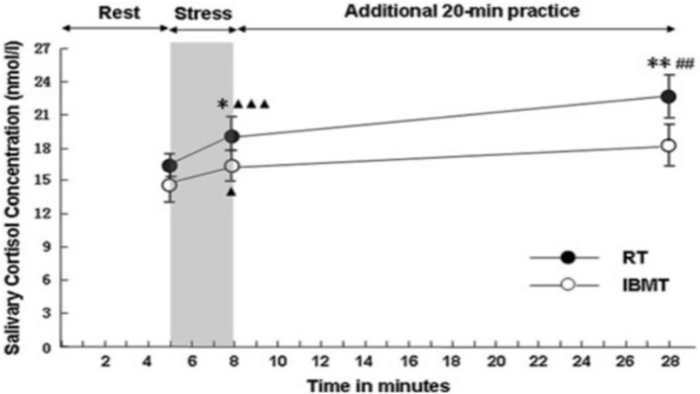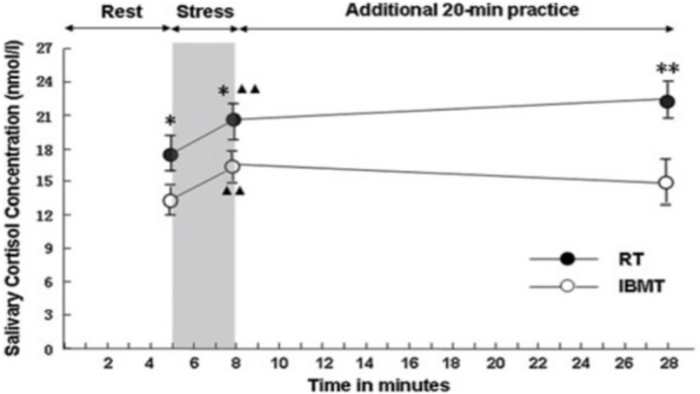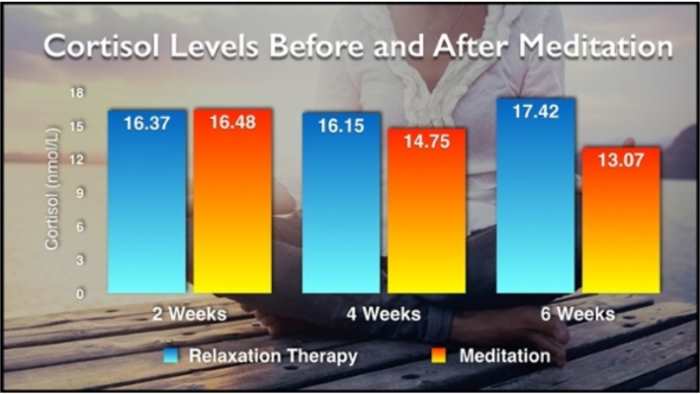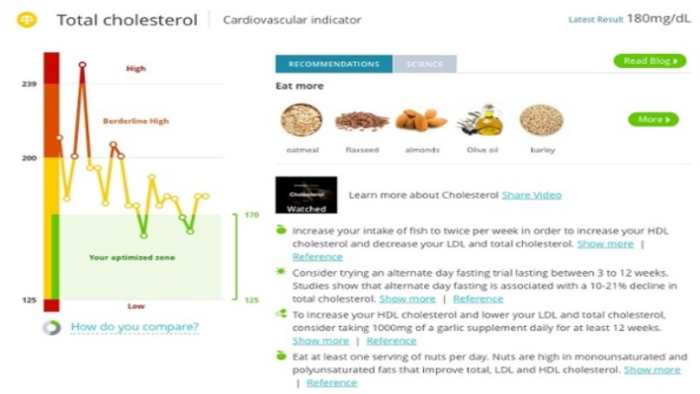What is meditation?
Meditation is hard to define in terms of modern-day medicine because of its many different spiritual, social, and cultural contexts. Its roots also go far back: historical documents trace meditation to Hindu traditions in India as early as 1500 BCE before it spread to China in the 5thcenturies BCE.2 According to psychology.com, a lot of meditation practices share the common goal of directing attention towards one point of reference. It may involve focusing on breathing, a certain object, or a phrase commonly referred to as a “mantra." It also typically involves avoiding distracting thoughts about the past and future and focusing on the present moment; oftentimes, this is described as “mindfulness.” One definition of meditation accepted by the medical community says it: “…refers to a family of self-regulation practice that focus on training attention and awareness in order to bring mental processes under greater voluntary control and thereby foster general mental well-being and development and/or specific capacities such as calm, clarity, and concentration” 3
Advantages of Meditation
Meditation is a stress-buster
Because meditation is most strongly associated with relaxing the mind, medical researchers are most interested in how practicing it regularly affects stress. Stress is any natural response of the human body or mind to a new demand.4 It allows us to keep up with new, short-term demands such as an athletic competition or looming work deadline. However, prolonged stress- known as “chronic stress”- can lead to detrimental, long-term effects on the mental and physical health of individuals. Harmful forms of stress include routine stress, such as a long commute to work, or traumatic stress of a sudden event such as the loss of a loved one. Chronic stress can negatively impact our health in the following ways: 4
Chronic stress is associated most heavily with increased levels of a biomarker called cortisol, which InsideTracker tests for. Cortisol is a steroid hormone produced by the adrenals in response to increased levels of stress.5 Our bodies need increased levels of cortisol to carry out many essential functions such as breaking down energy. However, prolonged, elevated levels of cortisol in response to chronic stress can lead to depression, a repressed immune system, and degradation of body tissues, including muscle.6 Over time, this can lead to a variety of diseases and make you less productive and unhappy. Clearly, we all want something that fights stress and helps manage cortisol levels...like meditation.
The scientific evidence
There's proof in the meditation pudding, so to speak. In 2013, researchers recruited 34 Chinese graduates (16 men and 18 women) for a four-week long intervention study. The subjects were an average age of 20.87 years old and no prior experience in meditation practice. Additionally, they had no history of autoimmune disease (i.e. Rheumatoid Arthritis and HIV) or mental illnesses such as depression. This group was pretty healthy, overall.
At the beginning of the study, researchers assigned the subjects to one of two groups. The first group of 17 served as the intervention group and performed an integrative body-mind training (IBMT) procedure that encompassed body relaxation, mental imagery, and mindfulness training associated with meditation. The researchers also included relaxing background music. The method ultimately emphasizes no control of one’s thoughts and an achievement of “restful alertness”.
The second group of 17 participated in a modern-day practice originating in the west called relaxation therapy (RT). RT is a form of relaxation that involves relaxing different muscle groups in the legs, shoulders, arms, head, face, chest, back, and abdomen with the assistance of a tutor. People performing RT usually have their eyes closed in a pattern and are forced to focus on relaxation and feelings of heaviness and warmth.
The researchers instructed all subjects complete education sessions about their respective relaxation methods for five days of four consecutive weeks. They received instruction both via CD and a certified meditation instructor. Two weeks and four weeks after starting their training, the subjects participated in a stress-intervention test with three-stages:
Researchers evaluated the levels of salivary cortisol before the stress, immediately after the stress, and immediately after the 20 minute practice. The levels of cortisol at a normal state of rest are referred to as “basal cortisol.”
Two weeks after the intervention, researchers noted that basal cortisol levels in the RT group changes non-significantly from 16.37 nmol/L to 16.15 nmol/L. 7 In contrast, basal cortisol levels in the IBMT group decreased by 10.5% from 16.48 nmol/L to 14.75 nmol/L. 7 During the first experimental stress reduction intervention, practicing IBMT also led to a lower increase in cortisol after the three-minute arithmetic stress session compared to the RT group.
Cortisol levels after the stress test two weeks into the study. Figure from Fan et. al
Four weeks into the study, the differences between the two groups in terms of cortisol became even more pronounced. In the RT group, salivary cortisol actually increased non-significantly from 16.37 nmol/L to 17.42 nmol/L. 7 In contrast, the basal salivary cortisol in the IBMT group decreased further to 13.07 nmol/L.7 Thus, this group experienced an overall decrease in basal cortisol of 20.1%. 7 Furthermore, during the second stress intervention, the RT group continued a slight increase in cortisol after their stress intervention. In contrast, the IBMT group had a decline in salivary cortisol levels after the stress intervention. 7
Cortisol levels after the stress test four weeks into the study. Figure from Fan et. al
Collectively, these results say that integrated meditation decreases general stress and anxiety as indicated by lower levels of basal cortisol. Additionally, as a practitioner continues meditation, they are able to decrease stress levels after a demanding event such as a math test. Because of these findings, the researchers stated ”the results indicate that IBMT produces a change in the basal endocrine system and larger acute effects as the dose of training increases” 7
The findings of this study are supported by several others. A study from last year on health care works showed that a 30 hour integrated meditation program quickly reduced basal cortisol levels and increased performance. 8 These subjects also became more resistant to stressful events after practicing meditation. 8 A Thai study from 2013 observed a 19.9% decrease in basal cortisol levels in 30 second- year medical schools after practicing mindfulness meditation for just four days. 9 Researchers of a four month study in which subjects practiced meditation daily for four months concluded “that repeated practice of… meditation technique reverses effects of chronic stress significant for health.” 10
One benefit that these studies overlooked is the fact that by decreasing cortisol, meditation also improve your immunity. This is because cortisol directs your body’s resources from the immune system and decreases your white blood cell production. Therefore, when looking at your InsideTracker results, pay close attention your white blood cell count to see what affects meditation has on you.
Key Takeaways: Practicing integrative meditation, which includes mental imagery and relaxing music, twice a day for 15 minutes is an effective stress management tool before challenging events. Conventional western techniques such as relaxation therapy are less effective at reducing stress and lowering cortisol. The effects of meditation are stronger as you progressively use it more.
Recommendation: If you are experiencing high levels of cortisol due to general stress or anxiety related to a demanding event such as a sports competition or academic test, consider practicing integrative meditation for as little as 5 minutes a day. Then, see if you can consistently meditate for 15-20 minutes once a day. To monitor the effects of meditation on stress, use InsideTracker to learn your cortisol levels as well as your white blood cell count.
Can meditation give you ninja-like reflexes?
In ancient times, Buddhist monks on the quest for greater spirituality weren’t the only ones who practiced meditation. Ninjas used it to sharpen their focus and reflexes so they could perform more. And Samurais practiced it daily to get that extra edge over their opponent.
Doesn’t it seem counterintuitive that meditation — where someone seems to be resting — makes someone more agile? Well, as usual, science holds the answer.
According to research, meditation is a highly effective way to increase reaction time, a key indicator of one’s ability to react to new environmental stresses. In a one week study, 10 college students who never practiced meditation completed 40 minutes of either nap, meditation, or control activities. Then, all of these subjects experienced one night of complete sleep deprivation followed by 40 minutes of meditation. All meditators were assessed through a psychomotor vigilance task (PVT), a timed task that measures the speed one takes to respond to a new visual stimulus such as a green or red light. When assessing the data, all 10 meditators improved their PVT reaction times after meditation (with a greater improvement after 10 minutes). In contrast, all but one subject lowered their reaction time after naps. Furthermore, after sleep deprivation, reaction time to tasks improved considerably after practicing meditation for 40 minutes. As a result of these findings, the researchers stated “these results suggest that meditation provides at least a short-term performance improvement even in novice meditators.” 11
Key Takeaways: Research indicates that meditation is a highly effective way to improve reaction time, a key indicator of alertness and agility. Recommendations: If you’re looking to get more agile, strongly consider incorporating meditation into your routine for 10-20 minutes a day. However, if you are ultimately blessed with ninja-like reflexes because of meditation, we highly recommend you don’t use them to harm anybody!
Meditation and heart health
Because the practice of meditation emphasizes relaxation and awareness, the bulk of clinical research on its impact on the body have focused on processes related to the mind. Recently, some scientists have sought to evaluate if meditation has an impact on heart health.
At InsideTracker, we get a snapshot of heart health by measuring triglycerides, total cholesterol, LDL cholesterol, and HDL cholesterol. Each biomarker has crucial functions to optimal body function. However, elevated levels of triglycerides, total cholesterol, and LDL cholesterol can greatly increase one’s risk of cardiovascular diseases such as stroke and heart disease. On the flipside, low levels of HDL cholesterol can increase the risk of cardiovascular diseases.
Last year, a group of researchers assessed the use of transcendental meditation (TM) in lowering the risk of cardiovascular diseases (CVD). In TM, subjects repeat a sound or chant called mantra to gain greater focus. They searched several literature databases for randomized controlled studies (RCTs) lasting at least three months that included healthy adults or adults with a high risk for developing CVD.
All studies evaluated at least one of three sets of outcomes:
Because of the very limited scope of the research, the authors of the evaluation stated that “we could draw no conclusions as to the effectiveness of TM for the primary prevention of CVD.” 12Additionally, they stated that “more and larger, long-term, high-quality trials are needed” to establish a potential relationship between meditation and prevention of CVD.12 That being said, meditation still holds the potential to benefit your cardiovascular health. One clinical trial on post-menopausal female found that regular practice of meditation lowered triglycerides and LDL cholesterol.13 A study from India observed a significant inverse association between individuals who regularly practice meditation and levels of triglycerides and total cholesterol the blood.14 Another South Korean study showed that subjects that walked for 40 minutes a day for three weeks along with regular meditation experienced greater declines in lipids compared to a control group. 15 High-quality intervention studies indicate that regular meditation practices lowers levels of blood lipids. A year-long study on 150 African-American subjects unveiled that 15-20 minutes of transcendental meditation are far more effective in lowering blood pressure than conventional relaxation therapy or health promotion.16 A recent meta-analysis of 19 studies on the short-term effects of meditation stated that “the regular practice of Transcendental Meditation may have the potential to reduce systolic and diastolic blood pressure by ~4.7 and 3.2mmHg, respectively. These are clinically meaningful changes.” 17 Finally, according to the American Heart Association, meditation lowers the risk of cardiovascular illness by decreasing stress and cortisol.
Key Takeaways: High-quality research assessing the impact of meditation on cardiovascular health is limited in scope. A couple of promising studies indicate that two 15-20 minute sessions of meditation daily may lower blood pressure when compared to health promotion and other relaxation techniques. One study suggests that meditation coupled with walking three times per week and no dietary changes may help optimize blood lipids.
Recommendations: If you want to improve your lipid related biomarkers and your cardiovascular health, consider using a more research-proven intervention in your recommendation engine such aerobic exercise or avocado. However, you can try meditation and see what effects it has on your lipid biomarkers, blood pressure, and cardiovascular health.
Summing up the research on meditation
Mental health benefits:
Heart health benefits:
Everyone can Learn to meditate
Here’s how:
First
make sure you set some time to get comfortable with meditation! Start sitting down, closing your eyes, and focus on a single point of preference for 5 minutes. You can also say a mantra (i.e. spiritual phrase) or add some relaxing background music.
Second
once you ease into it helps to refine your technique so you can get greater benefits. Some people interested in mediation consult with a certified instructor. We recommend checking out this awesome blog by Gaia.com.
Third
choose a meditation practice that fits your needs. One common form is transcendental meditation, in which the practitioner says a phrase called a mantra over and over again. Another mentioned in a study, called integrative body-mind training (IBMT), accompanies body relaxation and mental imagery along with music. There are many forms of meditation, and we encourage you to choose one that works best for you.
Finally
regularly monitor the progress that meditation has on you. Does it help your lower your cortisol and increase white blood cell count? Does it increase HDL cholesterol and lower blood pressure and reaction time? At the end of the day, your blood will tell you if meditation is the right tool for you and your mental health. Click below to get started.
List of References
- Everly Jr, George S., and Jeffrey M. Lating. A clinical guide to the treatment of the human stress response. Springer Science & Business Media, 2012.
- Walsh, Roger, and Shauna L. Shapiro. "The meeting of meditative disciplines and Western psychology: a mutually enriching dialogue." American Psychologist 61.3 (2006): 227
- Carlson, Neil R. Physiology of Behavior . Allyn & Bacon, 1986.
- Oswald, Lynn M., et al. "Relationship between cortisol responses to stress and personality." Neuropsychopharmacology 31.7 (2006): 1583-1591.
- Marieb, Elaine Nicpon, and Katja Hoehn. Human anatomy & physiology. Pearson Education, 2007.
- Fan, Yaxin, Yi‐Yuan Tang, and Michael I. Posner. "Cortisol level modulated by integrative meditation in a dose‐dependent fashion." Stress and Health 30.1 (2014): 65-70.
- Bottaccioli, Francesco, et al. "Brief Training of Psychoneuroendocrinoimmunology-Based Meditation (PNEIMED) Reduces Stress Symptom Ratings and Improves Control on Salivary Cortisol Secretion Under Basal and Stimulated Conditions." EXPLORE: The Journal of Science and Healing 10.3 (2014): 170-179.
- Turakitwanakan, Wanpen, Chantana Mekseepralard, and Panaree Busarakumtragul. "Effects of mindfulness meditation on serum cortisol of medical students." Journal of the Medical Association of Thailand= Chotmaihet thangphaet 96 (2013): S90-5.
- MacLean, Christopher RK, et al. "Effects of the transcendental meditation program on adaptive mechanisms: changes in hormone levels and responses to stress after 4 months of practice." Psychoneuroendocrinology 22.4 (1997): 277-295.
- Kaul, Prashant, et al. "Meditation acutely improves psychomotor vigilance, and may decrease sleep need." Behav Brain Funct 6 (2010): 47.
- Hartley, Louise, et al. "Transcendental meditation for the primary prevention of cardiovascular disease." The Cochrane Library (2013).
- Vyas, Rashmi, Kanti V. Raval, and Nirupama Dikshit. "Effect of Raja yoga meditation on the lipid profile of post-menopausal women." (2008).
- Mandape, Archana, Jyotsana Bharshankar, and Mrunal Phatak. "Effect of Raja Yoga Meditation on the Lipid Profile of Healthy Adults in Central India." (2015).
- Hur, Sun, and Seon-Rye Kim. "The Effects of Exercise Therapy on CVD Risk Factors in Women." Journal of physical therapy science 26.9 (2014): 1367.
- Schneider, Robert H., et al. "A randomized controlled trial of stress reduction in African Americans treated for hypertension for over one year." American Journal of Hypertension 18.1 (2005): 88-98.
- Anderson, James W., Chunxu Liu, and Richard J. Kryscio. "Blood pressure response to transcendental meditation: a meta-analysis." American journal of hypertension 21.3 (2008): 310-316.
Meditation Approaches
Meditation is an approach to training the mind, similar to the way that fitness is an approach to training the body. But many meditation techniques exist — so how do you learn how to meditate?
“In Buddhist tradition, the word ‘meditation’ is equivalent to a word like ‘sports’ in the U.S. It’s a family of activities, not a single thing,” University of Wisconsin neuroscience lab director Richard J. Davidson, Ph.D., told The New York Times. And different meditation practices require different mental skills.
an example of one of the most common approaches to meditation: concentration.
CONCENTRATION MEDITATION
Concentration meditation involves focusing on a single point. This could entail following the breath, repeating a single word or mantra, staring at a candle flame, listening to a repetitive gong, or counting beads on a mala. Since focusing the mind is challenging, a beginner might meditate for only a few minutes and then work up to longer durations.
In this form of meditation, you simply refocus your awareness on the chosen object of attention each time you notice your mind wandering. Rather than pursuing random thoughts, you simply let them go. Through this process, your ability to concentrate improves.
MINDFULNESS MEDITATION
Mindfulness meditation encourages the practitioner to observe wandering thoughts as they drift through the mind. The intention is not to get involved with the thoughts or to judge them, but simply to be aware of each mental note as it arises.
Through mindfulness meditation, you can see how your thoughts and feelings tend to move in particular patterns. Over time, you can become more aware of the human tendency to quickly judge an experience as good or bad, pleasant or unpleasant. With practice, an inner balance develops.
In some schools of meditation, students practice a combination of concentration and mindfulness. Many disciplines call for stillness — to a greater or lesser degree, depending on the teacher.
OTHER MEDITATION TECHNIQUES
There are various other meditation techniques. For example, a daily meditation practice among Buddhist monks focuses directly on the cultivation of compassion. This involves envisioning negative events and recasting them in a positive light by transforming them through compassion. There are also moving meditation techniques, such as tai chi, qigong, and walking meditation.
HOW TO MEDITATE: SIMPLE MEDITATION FOR BEGINNERS
This meditation exercise is an excellent introduction to meditation techniques.
- Sit or lie comfortably. You may even want to invest in a meditation chair or cushion.
- Close your eyes. We recommend using one of our Cooling Eye Masks or Restorative Eye Pillows if lying down.
- Make no effort to control the breath; simply breathe naturally.
- Focus your attention on the breath and on how the body moves with each inhalation and exhalation. Notice the movement of your body as you breathe. Observe your chest, shoulders, rib cage, and belly. Simply focus your attention on your breath without controlling its pace or intensity. If your mind wanders, return your focus back to your breath.
Maintain this meditation practice for two to three minutes to start, and then try it for longer periods.
Colours and meditation
Colour plays a role in our daily lives, sometimes subtly, sometimes dramatically. Some ancient cultures practiced chromo therapy, or using colours to heal. Chromo therapy, which is sometimes called light therapy, continues to be a popular holistic healing treatment. Psychologists and medical researchers have conducted hundreds of studies on the effect of colour on the psyche. Colour is used in advertising to induce us to formulate certain feelings about products and places. For example, studies have shown that the combination of blue and yellow attracts more buyers than any other combination; the color red has been shown to negatively impact students’ performance on exams; rooms painted blue has been shown to have a calming effect on prisoners. For the same reasons, focusing on color during your daily mediation can have a significant impact on your well-being.
Understand the relationship between color and the chakras.
Chakra is the Sanskrit word for wheel. There are seven chakras in the body, located in a straight line with your spine; this line runs down the center of your body, from the top of your head to the base of your spine. Each chakra is an energy center and is represented with its unique color. Color meditation involves focusing on each of your chakras and their color vibration in order to bring about balance in your mind and body; promoting healing and peace of mind. (Each of the chakras relates to the elements of Earth, air fire water, ether, spiritual awakening and enlightenment.) The seven chakras and their color associations are:
Red
This color represents the root chakra, located at the base of your spine. This is your life force and represents stability. Focusing on the color red and your root chakra will help you alleviate feelings of frustration, anger and raw passion. Physically, red is the color that stimulates your body and mind and increases your Circulation
Orange
This color represents the sacral chakra, located in the area of your naval. Focusing on the color orange and your sacral chakra will help you with issues involving sensuality, relationships, physical pleasure, emotional self-expression and creativity. Physically, orange is the color that stimulates your nervous system.
Yellow
This color represents the solar plexus chakra, located just below your breastbone. Focusing on the color yellow and your solar plexus chakra will affect your happiness, optimism and thought processes. Physically, yellow is the color that helps increase your overall vitality, mental alertness and analytical thought.
Green
This color represents the heart chakra, located in the center of your chest. Focusing on the color green and your heart chakra stimulates peace, love and nurturing. Physically, green is the color that induces healing.
Blue
This color represents the throat chakra, located at the base of your larynx. Focusing on the color blue and your throat chakra helps you with your self-expression and confidence. Physically, blue is the color that controls your thyroid gland and your lymphatic system, and affects your throat, neck and voice.
Indigo
This color represents the third eye chakra, located in the middle of your forehead. Focusing on the color indigo and your third eye chakra increases your intuition and your peace of mind. Physically, indigo is the color that affects your endocrine system.
Violet
This color represents the crown chakra, located at the top of your skull. Focusing on the color Violet and your crown chakra helps you align with universal consciousness. Physically, violet is the color that affects your pituitary gland.
Meditate on a specific color to address any emotional or physical dilemma you are facing. Before you begin your mediation, mentally assess your thoughts and your physical feelings. Do you have a relationship issue that is troubling you? Focus on red and your root chakra. Are you having trouble speaking up for yourself? Focus on the color blue and your throat chakra. If you are feeling a physical weakness anywhere in your body, focus on the color and chakra that affects those conditions.









